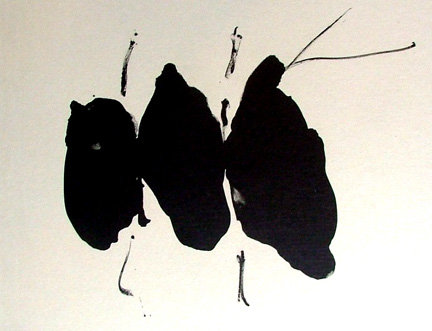Robert Motherwell
dal 3/11/2008 al 14/2/2009
Segnalato da
3/11/2008
Robert Motherwell
Fundacion Juan March, Cuenca
The exhibition presents 34 pages of partly illustrated texts from a portfolio of three poems by the Mexican poet, essayist and Nobel prizewinner Octavio Paz. Motherwell and Paz were close friends, dedicating works to each other, and the present collaboration arose from a visit by Motherwell to Mexico in 1967, a country in which he had already spent time in 1941. The folio was published in 1981-82. The present edition comprises texts in Spanish and English printed in two colours on Arches paper.

The exhibition presents 34 pages of partly illustrated texts from a portfolio of three poems by the Mexican poet, essayist and Nobel prizewinner Octavio Paz. Motherwell and Paz were close friends, dedicating works to each other, and the present collaboration arose from a visit by Motherwell to Mexico in 1967, a country in which he had already spent time in 1941. The folio was published in 1981-82. The present edition comprises texts in Spanish and English printed in two colours on Arches paper on which 27 lithographs were subsequently printed at Trestle Editions in New York, four of them in colour. On display is one of the three hors commerce sets from the edition. Octavio Paz had published the three poems – “San Ildefonso Nocturne”, “Return” and “Skin/Sound of the World” – for the first time in 1976 on his return to Mexico after having spent most of his life from 1943 onwards in Europe, India and the United States. The last of the three poems was written in 1971, inspired by his contemplation of the work of Motherwell.
Robert Motherwell (Aberdeen, Washington, USA, 1915 – Provincetown, Massachusetts, USA, 1991) was the youngest member of the first generation of American Abstract Expressionists. He is also noted for his extensive writings on art and his large output of prints. Motherwell obtained his degree in philosophy, starting his studies at Stanford University and completing them at Harvard. Alongside these activities he began to develop his artistic skills from an early age, and was awarded a grant to study at the Otis Art Institute in Los Angeles. Following a trip around Europe in 1938 he decided to devote himself seriously to painting. In 1941 after a trip to Mexico with the Surrealist artist Roberto Matta, Motherwell decided to dedicate all his energies to painting and moved to Greenwich Village in New York. During the 1940s he was significantly influenced by the European Surrealists. Motherwell’s art reveals his passionate interest in history, literature and the human condition and from the outset he pursued the idea of evoking a moral and political experience through his works. This is evident, for example, in the fact that throughout his career James Joyce provided the inspiration for the titles of his paintings, drawings and prints. In addition, a poem by Federico García Lorca inspired Motherwell to produce 200 works on the theme of Elegy to the Spanish Republic which arose from his concerns regarding the Spanish Civil War.
In the 1940s Motherwell made contact with the group of New York-based artists who would soon become known as the Abstract Expressionists. He first started to exhibit with them in group and solo shows featuring markedly gestural paintings. In the late 1960s Motherwell began his Open series that clearly moved away from his gestural style of painting and were characterised by fields of colour outlined with charcoal and suggesting a door or window. Motherwell pursued both these modes of painting until the end of his career, one more expressive and the other more austere. In addition he produced collages and collaborated with printmakers..
Coordinator: Antonio Garrote agarrote@mail.march.es
Fundacion Juan March
Casas Colgadas, s/n - Cuenca
Hours
Tuesday-Friday: 11 a.m. - 2 p.m.
and 4 p.m. - 6 p.m.
Saturday: 11 a.m. - 2 p.m.
and 4 p.m. - 8 p.m.
Sunday/Holidays:: 11 a.m. - 2:30 p.m.
Monday: Closed.
The Museum is also closed on: January 1, Holy Thursday, Holy Friday, September 18, 19, 20 and 21;
December 24, 25, 31



